Canada is home to over 1,779 different species of vertebrate animals, ranging from mammals, birds, fish, and reptiles. That number excludes a couple thousand invertebrate species, such as insects and arachnids. However, only around 300 species of animals, plants, and fungi are endemic to Canada. Those species can be found throughout Canada’s major biomes, like grasslands and tundra, as well as boreal and deciduous forests.
With such diverse wildlife, there are bound to be certain animals in Canada that aren’t quite as smart as other species. Join us, as we discuss the 10 dumbest animals found in Canada.
1. Hooded Seal (Cystophora cristata)
The hooded seal is a large true species of seal and the sole mammalian species in the Cystophora genus. These arctic seals can weigh up to 900 pounds and frequent the Atlantic coast of Canada. Hooded seals are identified by their silver-gray fur with dark markings throughout. One of their most noticeable features is the male’s bizarre nasal cavity which has earned them a top spot on this list.
The male hooded seal’s nasal cavity consists of two lobes, one of which can inflate to twice the size of the head. This balloon-like elastic membrane boasts a red coloration that stands out against the seal’s otherwise drab body. When the inflated nasal cavity is shaken, it makes a strange pinging sound.
Although their nasal cavity is used to defend their territory and attract females, it doesn’t make them look any less dumb. Their inflated nasal cavity often blocks their view, making for a hilarious spectacle as they wobble around the ice making strange sounds.
2. Pronghorn (Antilocapra Americana)
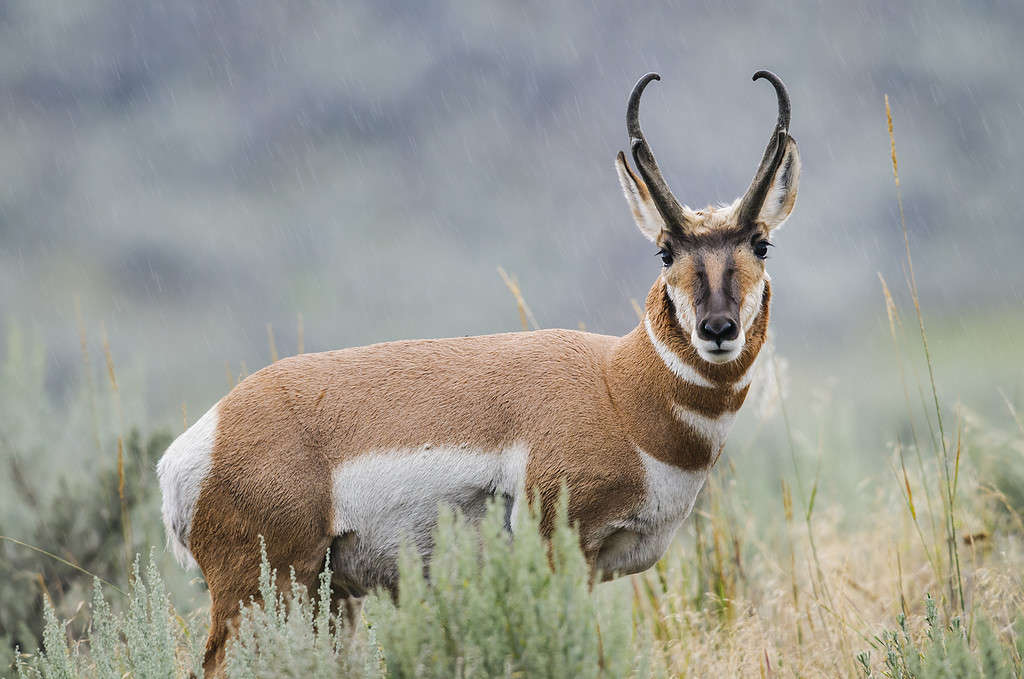
The swift pronghorn is the fastest land animal in North America.
©bgsmith/iStock via Getty Images
Pronghorns are a type of artiodactyl found throughout western and central North America. Both males and females have a reddish-brown coloration and tiny 4-inch-long tails against their white rump. The male pronghorn has lyre-shaped horns, hence their name. While their appearance is quite normal, their intelligence is questionable when it comes to passing fences.
Pronghorns experience a major setback when faced with man-made fencing, which most seem reluctant to jump. Pronghorns can jump 8 feet into the air, so they are fully capable of jumping over most fences. Instead, pronghorns prefer to clamber underneath the fence, either getting stuck or sporting a bald patch on their back afterward. Efforts have been made to replace the bottom parts of fences with smooth wiring to make it easier for pronghorns to pass fences when they migrate.
3. Sockeye Salmon (Oncorhynchus nerka)
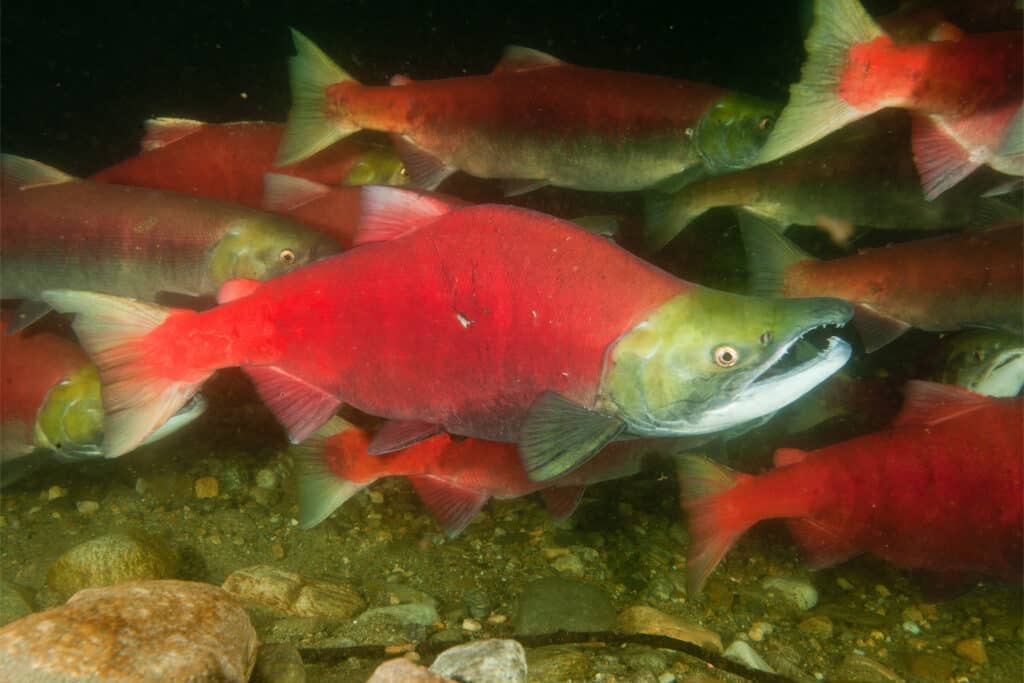
Sockeye salmon turn red during spawning from carotenoids in their diet.
©Beat J Korner/Shutterstock.com
The sockeye salmon has a striking appearance and usually grows to 2 feet long and weighs up to 15 pounds. Sockeye salmon is an anadromous species that can be found in both freshwater and saltwater habitats from the Fraser River systems to the Northern Pacific Ocean. They are generally a blueish silver coloration, but they develop a vivid red body and jade-green head during spawning. However, their appearance is not the only thing that changes during spawning. Their bodies will undergo physiological changes to prepare them for a taxing spawning season.
Sockeye salmon have earned the name “zombie fish” because they die shortly after breeding. Most sockeye salmon only reproduce once in their lifetime before their organs deteriorate and they eventually die. Their failing organs are susceptible to fungi and bacteria that causes their body to decay over the next two to eight days. Sockeye salmon use all of their energy to produce eggs, build nests, and migrate from the ocean to freshwater lakes.
They usually do not have the energy to return to the ocean and encounter rapids and waterfalls that they need to save their energy to pass through. Most sockeye salmon have an average lifespan of 5 years before dying.
4. Plains Hog-Nose Snake (Heterodon nasicus)
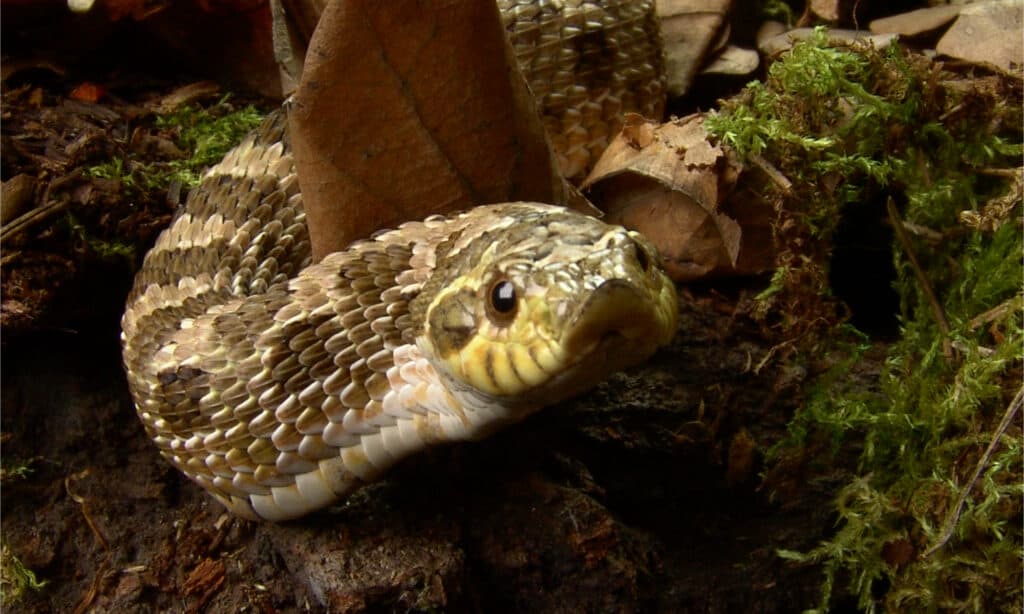
Plains hog-nose snakes have a weak venom that is not dangerous to humans, but rather to their prey.
©skifbook/Shutterstock.com
The plains hog-nose snake (also known as the western hognose) is one of the more dramatic animals on this list. These snakes are endemic to North America and can be found throughout southern Canada. Their habitat consists of sandy grasslands since they prefer to burrow to escape harsh weather. Plains hog-nosed snakes are named after their upturned snout that they use to find prey and burrow in sandy substrates. While their appearance might look adorable, their behavior is comical.
When feeling threatened or faced with a predator, the plains hog-nosed snake sometimes plays dead. Their dramatic display of decease involves rolling onto their backs and sticking out their tongue. However, they usually result in this behavior when other methods of defense have failed. The plains hog-nose snake takes their act of fake death seriously enough to emit a foul odor to smell dead too.
5. Killdeer (Charadrius vociferous)
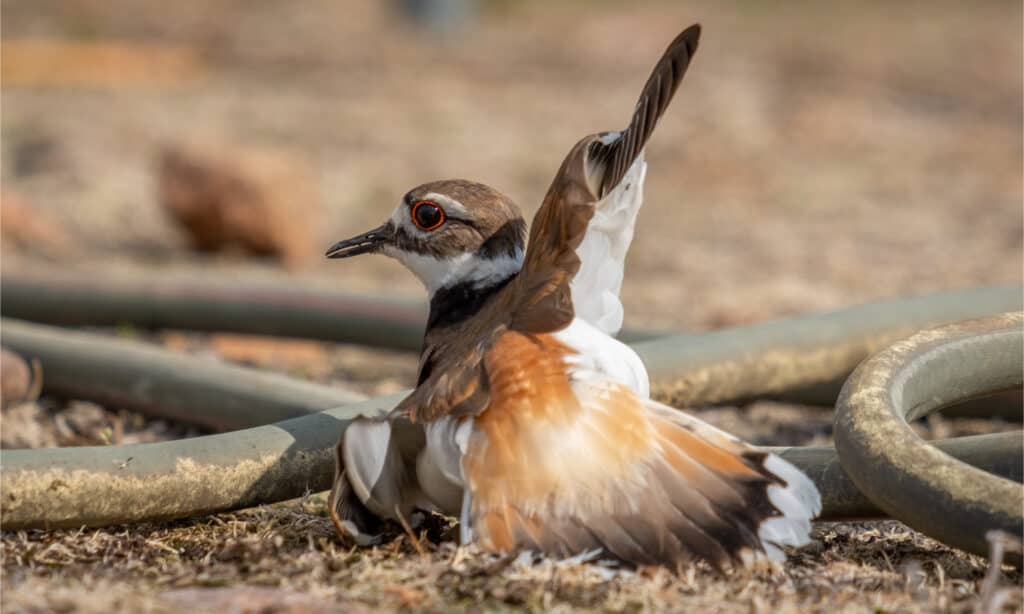
Killdeer feign injury to lure predators away from their nests.
©samray/Shutterstock.com
One of the dumbest birds in Canada happens to be the killdeer, a plover from the Charadrius genus. Killdeers are medium birds around 10 inches in size and can be found throughout southern Canada. They are regarded as dumb birds because of their behaviors that many deem questionable. Killdeers will lay eggs on the ground, sometimes even in parking lots. The main reason birds create nests in trees or above ground is to keep their eggs and chicks safe, but the killdeer is an exception.
Since killdeers do not lay their eggs in a safe place, they resort to pitiful strategies to protect their young. Killdeers will often fake an injured wing and emit distress calls to lure predators away from their nest. This distraction display usually works, but sometimes gets them killed or taken in for “rehabilitation” by unknowing passersby.
6. Greater Short-Horned Lizard (Phrynosoma hernandesi)
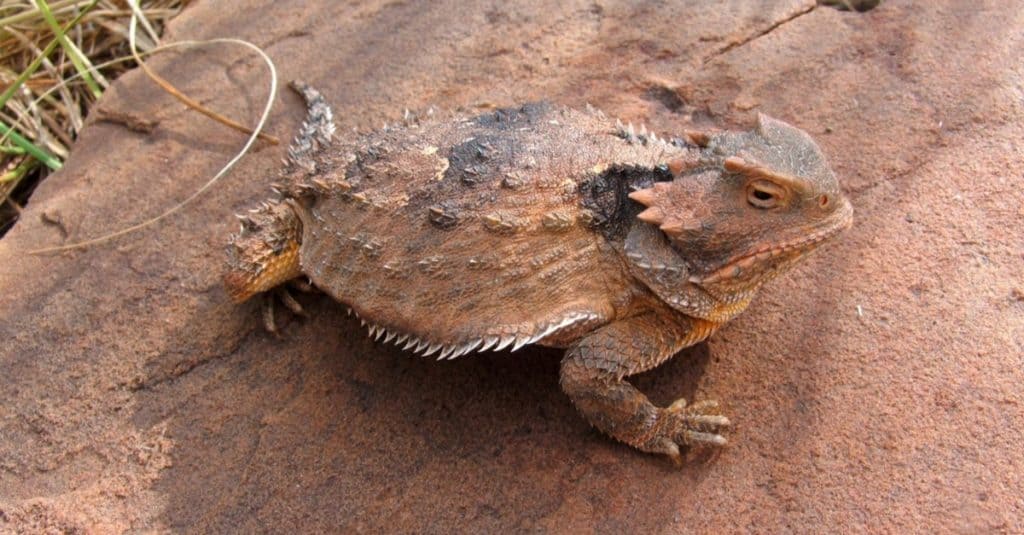
These lizards can shoot blood from their ocular sinuses underneath their eyes.
©Matt Jeppson/Shutterstock.com
The greater short-horned lizard can be found in parts of Alberta and Saskatchewan in Canada. They are identified by their small size at 5 inches long, round, and flattened bodies, and mini horns. Although they are sometimes mistaken for pygmy short-horned lizards, they are their own species. These lizards are commonly observed lying flat on the ground as they camouflage with the surrounding terrain.
As ambush predators, the greater short-horned lizard will wait for their prey to find them before they attack. One of the greater short-horned lizards’ most interesting behaviors is their ability to shoot blood from their eyes. This is done as a rare defense mechanism to protect them from predators such as coyotes.
The blood is released from their ocular sinuses just below their eyes and can shoot up to three feet. Chemicals in the blood give it a bad taste that is deterring to most canines. This defense mechanism is equally gross and weird, and quite a sight to witness.
7. Slimy Sculpin (Cottus cognatus)

The slimy sculpin lacks a swim bladder organ.
©Sanchos303/Shutterstock.com
Slimy sculpin is a freshwater fish in the Cottus genus that inhabits rocky lakes and streams in northeastern Canada. These fish are recognized by olive-brown coloration, flattened head, protruding upper lip, and small size at 3 inches long.
Slimy sculpins are active bottom dwellers and spend most of their time swimming and hiding amongst rocks and logs. The slimy sculpins’ dumbest feature is their lack of a swim bladder organ which makes fish buoyant in the water. Without a swim bladder, the slimy sculpin has abnormal swimming behaviors which explains why they are bottom-dwelling fish with no choice.
These inefficient swimmers will move by hopping around. Other than their inability to swim normally, male slimy sculpins have a coloration that gets them killed. The males have orange in their dorsal fin which disrupts their camouflage and makes them easier for predators to spot. However, this orange coloration makes them more attractive to females and is necessary for reproduction.
8. Spiny Softshell Turtle (Apalone spinifera)

Unlike many other species of turtles, spiny softshell turtles do not have a hard shell.
©iStock.com/Brian Reinke
Found in Southern Ontario and Southwestern Quebec is Canada’s strangest turtle, the spiny softshell. This species of turtle has a flattened shell, webbed limbs, and an abnormally long snorkel-like nose. You can find them inhabiting freshwater rivers, ponds, and lakes with plenty of aquatic vegetation and nearby sandbars.
The spiny softshell turtle is a bimodal or pharyngeal breather that can respire underwater by breathing using their buccopharynx and cloaca. As their name suggests, this species of turtle has a soft, leathery shell which doesn’t offer them much protection. Spiny softshell turtles are endangered in Canada, and face predators like humans, alligators, and foxes. Their main form of defense is their strong bite and camouflage since their shell is easily damaged.
Furthermore, spiny softshell turtles spend a few months dormant underwater where they bury themselves in sand with their snorkel-like nose sticking out.
9. Organ Pipe Mud Dauber (Trypoxylon politum)

The holes in this wasp’s pipe-like nests indicate that freshly hatched adults have successfully emerged.
©IrinaK/Shutterstock.com
The organ pipe mud dauber is a type of wasp recognized by their unusual nests and shiny black coloration. These predatory wasps can be found in southeastern Canada and are considered common pests.
Organ pipe mud daubers are named after their pipe-shaped nests which they construct from nearby mud. They nest on various smooth surfaces that are protected from rainfall, even in human infrastructure. Their nests often leave stains behind on walls and create unsightly visuals. However, that is not what makes the organ pipe mud dauber dumb.
Female organ pipe mud daubers will create layered nests, which sometimes decreases the success rate of their offspring who need to chew their way out of the pipes. They seal off the pipes with a mud cap and the offspring need to chew through the pipes to escape. The more pipes clustered on top of each other, the more difficult it is for the newly hatched adults to emerge.
You see, the organ pipe mud daubers’ offspring hatch from their eggs and feed off of paralyzed spiders until they pupate. Once they hatch, the new adults will leave the nest to create their own.
10. Singing Vole (Microtus miurus)
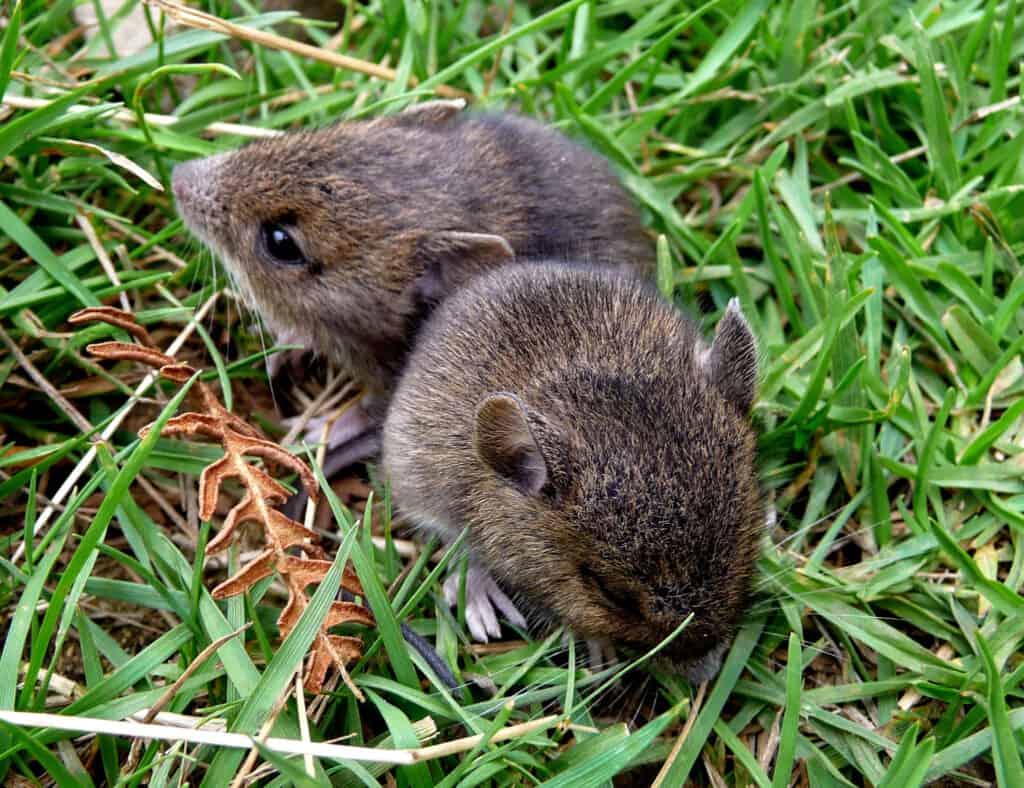
Voles have a very short lifespan, often between three to six months.
©gailhampshire from Cradley, Malvern, U.K, CC BY 2.0 <https://creativecommons.org/licenses/by/2.0>, via Wikimedia Commons – Original / License
The last animal on our list is the singing vole, a 2-ounce rodent known for its interesting vocals. Singing voles are distinguished by their small size, short ears, and tawny-colored fur. They are found in northwestern Canada where they inhabit the alpine tundra of the Mackenzie Mountains.
Male singing voles have interesting vocals that they use to defend their territories and for courtship. Generally, the more impressive the song is, the more attractive he might be to the females. They make various high-pitched squeaks or melodies, including a warning trill from their burrows. Singing voles will also large stacks of dried grasses on nearby tree roots or branches to dry out for winter.
While this might seem smart, these stacks of grasses are often eaten by other animals or blown away in the wind. Most singing voles do not make it to their first winter, as they have a short average lifespan of three to nine months.
In Summary
The killdeer and plains hog-nose snake seem to top the list of Canada’s dumbest animals, while the hooded seal and spiny softshell turtles are the dumbest looking. Most Sockeye salmon turn into zombies after spawning, and slimy sculpins cannot swim properly, even though they are fish.
There is no doubt that Canada is home to some dumb animals who display questionable behavior. However, each animal has its place in the ecosystem, whether highly intelligent or downright dumb.
Summary of the 10 Dumbest Animals in Canada
| Rank | Animal |
|---|---|
| 1 | Hooded seal |
| 2 | Pronghorn |
| 3 | Sockeye salmon |
| 4 | Plains hog-nose snake |
| 5 | Killdeer |
| 6 | Greater short-horned lizard |
| 7 | Slimy sculpin |
| 8 | Spiny softshell turtle |
| 9 | Organ pipe mud dauber |
| 10 | Singing vole |
The photo featured at the top of this post is © iStock.com/Brian Reinke
Thank you for reading! Have some feedback for us? Contact the AZ Animals editorial team.







